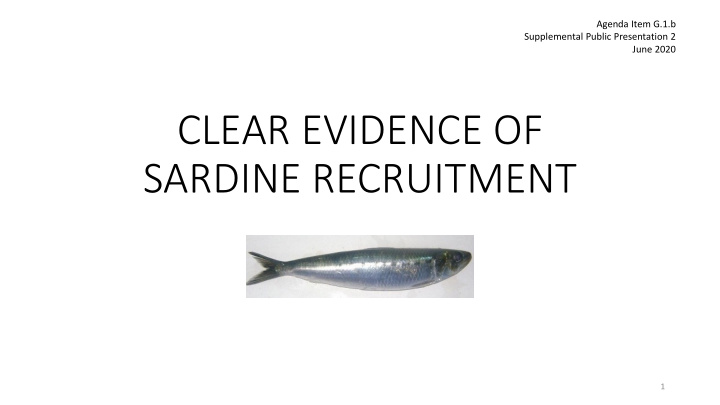



Agenda Item G.1.b Supplemental Public Presentation 2 June 2020 CLEAR EVIDENCE OF SARDINE RECRUITMENT 1
RANG NGE O OF FISH S SIZES FOUN UND I IN N SARDINE C CATCH JUNE 8 8, 2020 020 2
JUNE 8 8 202 020 S 0 SARDINE L LANDING F G FURTH THER DE R DETAILS • Sardine catch of one vessel the FV Trionfo (Captain Neil Guglielmo) – June 8 ‘20 • 2 sets made: (first set ~25 ton – 1:30am; second set ~ 10 ton – 4am) • Random sampling and testing overall catch can be described as follows: Avg 80gms (std dev 11gms) Avg 21cms (std dev 0.7cms) • BUT, we looked closer and found fish in all the size ranges shown on the previous photo • Smallest fish found in the 10-29gms size category on the attached photo was 20gms • Largest fish found in the 200gms/up size category was an incredible 280gms!! 3
RANG NGE O OF FISH S SIZES FOUN UND I IN N SARDINE C CATCH JUNE 5 5, 2020 020 4
JUNE 5 5 202 020 S 0 SARDINE L LANDING F G FURTH THER DE R DETAILS • Sardine catch of one vessel the FV Trionfo (Captain Neil Guglielmo) – June 5 ’20 • 2 sets made • Random sampling and testing (147 observations) overall catch can be described as follows: Avg 72gms (std dev 16gms) Avg 20.5cms (std dev 1.1cms) 5
RANGE GE OF F OF FISH S SIZES F FOUND I IN SARDINE C CATCH JUNE 1 E 10-11, 2 2020 6
JUNE UNE 1 10-11 2 2020 S SARDINE LANDING F FUR URTHE HER D DETAI AILS • Sardine catch of one vessel the FV Trionfo (Captain Neil Guglielmo) – June 10-11 ’20 • 2 sets made (one set June 10 pm – one set June 11 early am) • Random sampling and testing (178 observations) overall catch can be described as follows: Avg 58gms (std dev 20gms) Avg 19.1cms (std dev 2.0cms) UNDER 30 GMS 2.74% 30-40GMS 13.11% 40-50GMS 7.21% 50-60GMS 14.58% 60-70GMS 7.43% 70-80GMS 34.38% 80-90GMS 18.80% 90-120GMS 1.76% 7
MIXED XED A AGE C CLASS LANDINGS ARE A E A COMMON ON T THI HING I IN THE S E SHA HALLOW INSHORE W WATER ERS W WHER ERE OUR B R BOATS FISH • It has been very common over the now almost 30 years of being involved with sardine and anchovy fishing and studying the catches we have processed, that mixed age class landings are very common in the inshore waters where we fish. • This is very noticeable in Monterey landings. But this was also true of landings made in coastal waters of Ventura and Santa Barbara counties – and offshore at the Channel Islands • Common to see only young juvenile fish in our catches then suddenly schools of larger / older fish migrate into the shallower waters where our boats were fishing and mix with the juvenile fish for a time, then migrate away, once again leaving primarily juvenile fish. • WHERE you are seeking evidence of recruitment makes a huge difference on whether you will find that evidence, OR NOT)!! • It is very important to include inshore biomass in surveys going forward. • Our industry is willing and able to provide the data now missing from stock assessments. 8
WEIGH GHT V VS LENG NGTH 9
WEIGH GHT V VS LENG NGTH 10
WEIGH GHT V VS LENG NGTH 11
WEIGH GHT V VS LENG NGTH 12
WEIGH GHT V VS LENG NGTH 13
IMPORTANCE O E OF A ALWAYS HA HAVING A AT LEAST A SMALL D DIRECTED FISHERY Y AND ND W WORKING W WITH I IND NDUS USTRY T Y TO ADVAN ANCE T THE HE S SCIENC NCE IT IS A KNOWN THAT SARDINE AND ANCHOVY BIOMASSES VARY MOSTLY WITH ENVIRONMENTAL CONDITIONS AND ARE IN CYCLICAL IN NATURE 14
IMPORTANCE O E OF A ALWAYS HA HAVING A AT LEAST A SMALL D DIRECTED FISHERY Y AND ND W WORKING W WITH I IND NDUS USTRY T Y TO ADVAN ANCE T THE HE S SCIENC NCE • Even when biomasses are low, small directed fisheries like the EFP directed fishery we are participating in now will yield valuable scientific data to better inform stock assessments for the future • We thank the Council for supporting this directed fishing EFP • We encourage the Council to support Alternative 1, with no more restrictions than ‘status quo’ management, so this EFP fishery can continue providing data to improve future stock assessments. QUESTIONS? 15
Recommend
More recommend